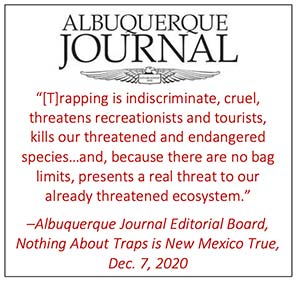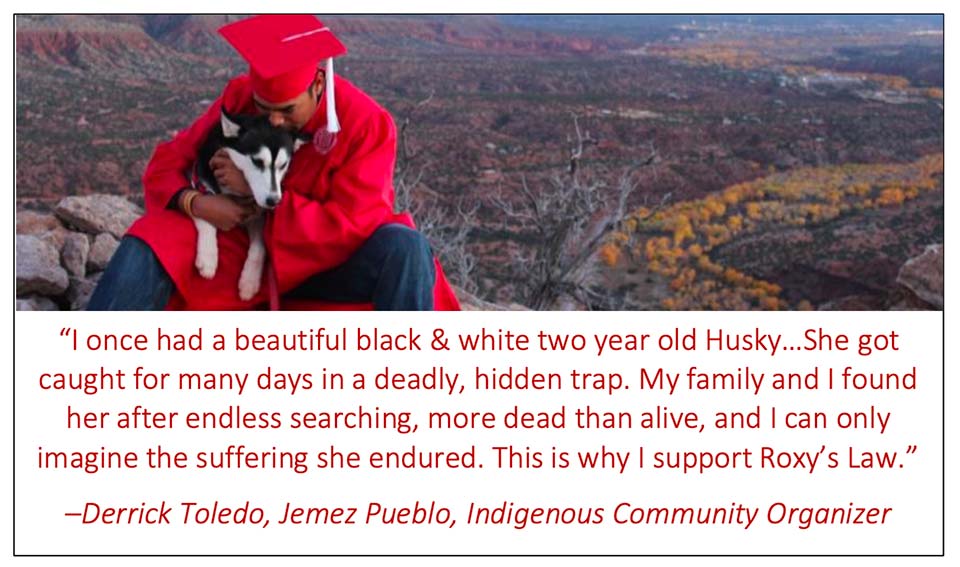
Read the Albuquerque Journal Editorial here
Co-Sponsored by Senator Roberto “Bobby” Gonzales, Senator Brenda McKenna, Representative Matthew McQueen, Representative Christine Chandler
DOWNLOAD THE SB32 “ROXY’S LAW” FACT SHEET
[ UPDATED MARCH 12, 2021 – 188 KB PDF ]
ABOUT THE BILL
- Prohibits all traps (leghold, body-gripping, cage traps), snares, and wildlife poisons
- Applies to public land only – defined in the bill to include lands owned, leased, or held in trust by the state, federal, local governments; but not Indian nation, tribe, or Pueblo lands or the inside of structures
- With explicit exemptions for:
- All other types of hunting, fishing, archery, falconry, etc.
- The taking of birds, fish, or rodents not classified as “furbearers”
- Protecting human health and safety by a government entity
- Ecosystem management by Dept. of Game & Fish, US Fish & Wildlife Service, or conservancy districts
- Bona fide scientific research
- Dept. of Game & Fish acting on nuisance/depredation complaints using non-lethal traps or snares
- Cage traps to protect property/crops/livestock, or to recover lost or feral domestic animals
- Use by a member of an Indian nation, tribe, or pueblo for religious or ceremonial purposes
- Establishes misdemeanor penalties for persons who violate the law
WHY BAN TRAPS, SNARES, POISONS ON PUBLIC LANDS? BECAUSE THEY:
- Undermine Other Uses of Public Lands & Harm Our Outdoor Recreation and Tourism Economy: Traps, snares, and poisons endanger people and pets who are engaging in hiking, camping, fishing, horseback riding, hunting, cross-country skiing or snowshoeing, wildlife watching, backpacking, climbing, or nearly any other activity one can imagine. And, while trapping season spans November through mid-March, these devices can be legally set for some species year-round.
- Violate the North American Model of Wildlife Conservation: Unlike hunted game species, furbearer species targeted by traps, snares, and poisons can be taken in unlimited numbers and sold in commercial markets. This drains a public resource for private profit, violating the North American Model supported by ethical sportsmen and NM Dept. of Game & Fish.
- Harm Non-Target Wild & Domestic Animals: Traps often maim or kill non-target animals and there are many past instances across the state, including trapped black bears, endangered wolves, mountain lions, and wild native birds. Along with non-target wildlife, leghold traps have injured or killed domestic dogs or cats in nearly every county in New Mexico, including in sparsely populated rural and wilderness areas.
- Injure & Kill Endangered Species: As an example, of the at least 46 endangered Mexican wolves trapped in New Mexico in the past two decades, 43% were injured. Of all injured wolves, 42% died. In comparison, in the same time period, just 4 wolves were accidentally trapped in Arizona where traps are already banned on public lands.
- Subject Animals to Unnecessary Cruelty: Trapped and snared animals are subject to prolonged pain, dehydration, starvation, broken bones, predation, dislocation, self- amputation, trauma & death. If found alive, wildlife is typically dispatched by bludgeoning, choking, or torso-stomping in order to preserve the pelt for commercial sale. Roxy, a senior heeler, strangled to death in a neck snare on public land in 2018.
ADDRESSING CONCERNS AND MISCONCPETIONS
New Mexicans Broadly—Including Rural and Urban Dwellers—Oppose Traps, Snares, and Poisons on Public Lands. Polls over recent years have shown that New Mexico voters, statewide, support banning these devices from public lands by approximately a 2-1 to 3-1 margin.
Fur Trapping is Not a Key Source of Income for an Average Trapper: The fur market has been in decline for years, as supply far outpaces demand and fashion brands swear off the use of fur. The average NM trapper who attempted to sell every harvest from the ‘18-‘19 season grossed only $264.54–$440.76.
Traps, Snares, and Poisons Are Not Necessary to Protect Livestock or Control Wildlife Populations – Traps, snares, and poisons were banned in neighboring Colorado (statewide) and Arizona (public lands) in the mid-1990s. In those states, cattle depredation rates by wild carnivores are actually lower than in New Mexico. Recent published research confirms that mass trapping of many carnivore species actually increases breeding within the pack due to social structure disruption and results in overall population increase.

SUMMARIES OF KNOWN NEW MEXICO TRAPPING INCIDENTS IN THE ‘20-‘21 TRAPPING SEASON
- Nov. 14 – Lake Farmington, a Siberian husky named Ivy was trapped, $750 in vet costs
- Nov. 20 – Santa Teresa, skinned coyote carcass piles found, evidence suggesting a trapper dump site
- Nov. 21 – Northern Santa Fe County, hikers found a lost dog languishing in a leghold trap; Rescue groupsaved dog named Mahlia and provided costly veterinary treatment including amputation of several toes
- Nov. 26 – Jemez National Recreation Area, a trained search and rescue dog Jessie the Dutch shepherdwas trapped on a hike with her human, experienced swelling and a split nail on her foot.
- Dec. 2 – Bernardo, a quail hunter’s German shorthair pointer was trapped during a hunt, minor injuries
- Dec. 17 – Santa Fe Nat’l Forest, heeler named Cruzer trapped, couldn’t put weight on bruised leg
- Dec. 30 – Rowe Mesa, dog Nelli trapped while her human was collecting wood
- Jan. 6 – Rio Rancho, concerned citizens reported a coyote limping with a trap attached to his foot
- Jan. 11 – Lincoln Nat’l Forest, Tooli was trapped while hiking on forest road and was difficult to release
- Jan. 23 – Caja del Rio Plateau: hiker came upon skinned bobcats presumably dumped by area trapper
- Jan. 26 – Dixon: German shepherd named Ceniza found choking in a neck snare in a nearby arroyo.
- Feb. 2 – Dixon: 10-yr-old heeler/shepherd caught in two leghold traps in an arroyo in northern foothills
SUPPORTING ORGANIZATIONS
Amigos Bravos, Animal Protection Voters, Born Free USA, Center for Biological Diversity, Conservation Voters New Mexico, Defenders of Wildlife, Endangered Species Coalition, Humane Society Veterinary Medical Association, Mountain Lion Foundation, New Mexico Wild, Project Coyote, Sandia Mountain Bear Watch, Sierra Club, Southwest Environmental Center, TrapFree New Mexico, WildEarth Guardians, Wildlife Conservation Advocacy Southwest.
